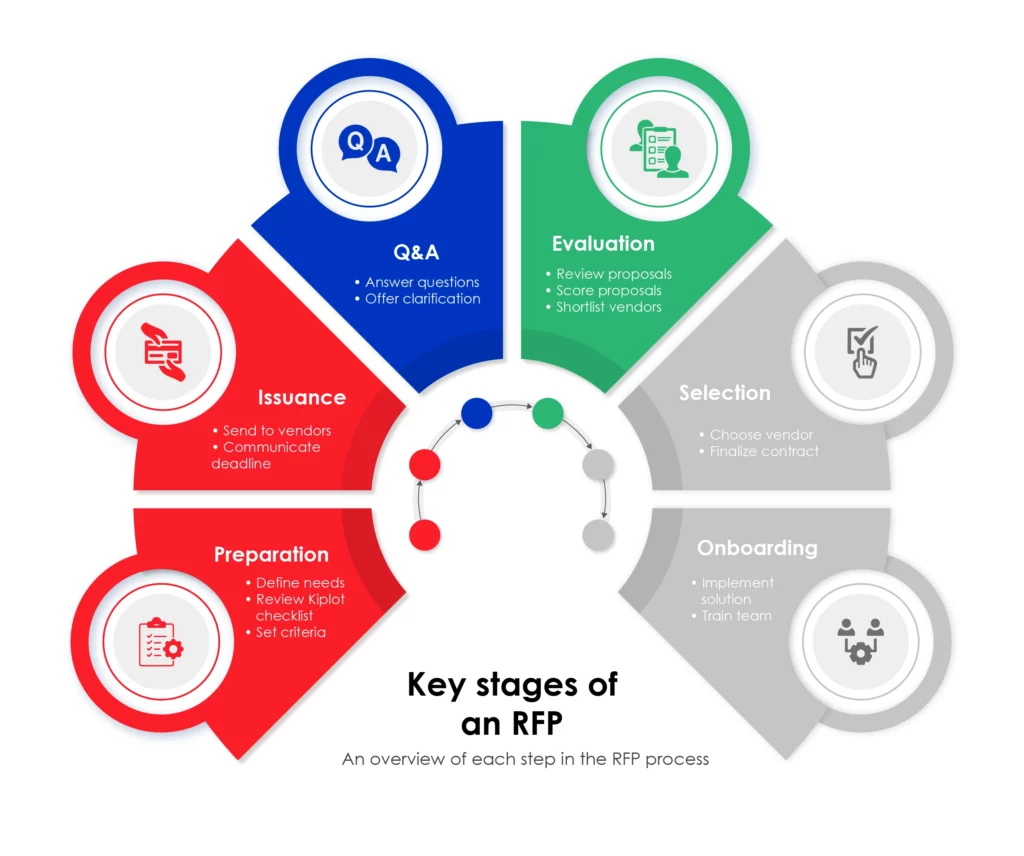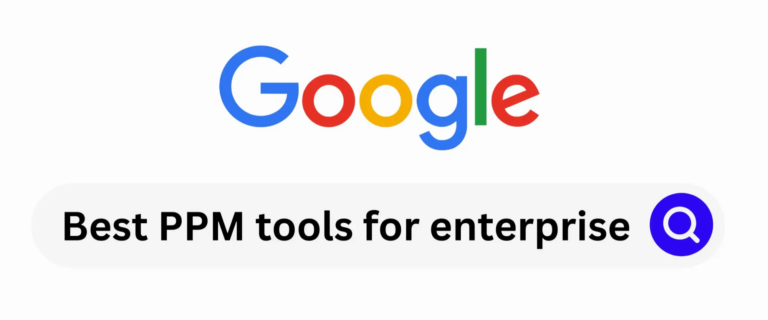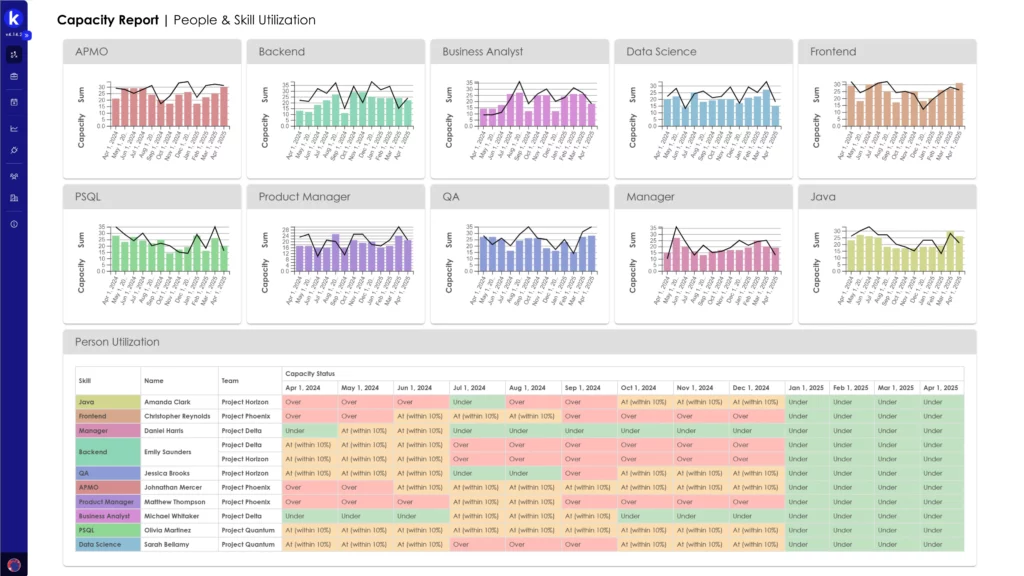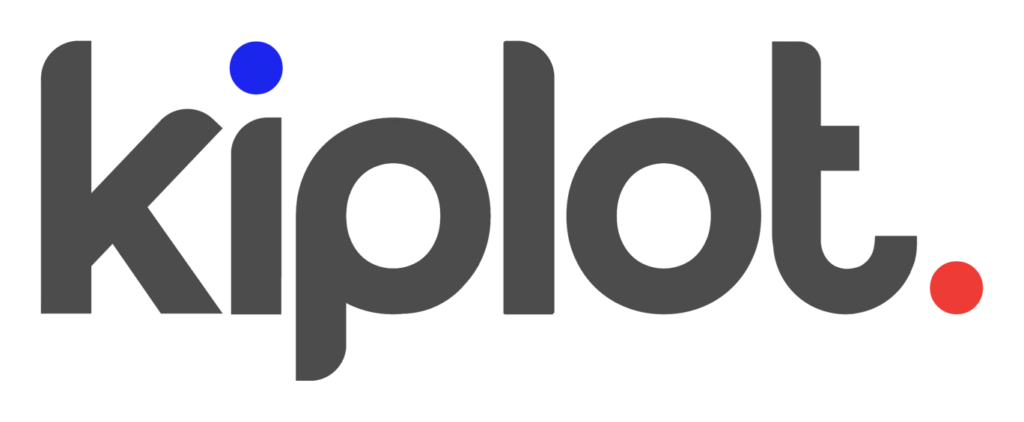Download the pre-built template
To streamline the process, our downloadable template offers a starting framework, helping you cover essential elements while tailoring specifics to your unique requirements.
The definitive guide to crafting an RFP for enterprise PPM tooling
Introduction
This year, Kiplot has been chosen in every RFP we’ve participated in – a clear reflection of how deeply we understand the priorities of decision-makers in enterprise project portfolio management. Selecting a PPM tool is a strategic decision that goes beyond checking feature boxes. It requires identifying a solution that integrates seamlessly with your PPM frameworks, strengthens data cohesion, and optimizes resources to drive measurable value creation across teams.
This guide is designed to help you craft an RFP that addresses these priorities. You’ll find practical dos and don’ts, alongside nuanced questions that enable you to evaluate vendors on their ability to support your organization’s goals, equipping you to assess vendors based on the factors that truly drive value and performance.
What is an RFP?
A Request for Proposal (RFP) is a formal document organizations use to outline their requirements and invite vendors to propose tailored solutions. In enterprise portfolio management, an RFP is a strategic tool to ensure the chosen software aligns with your organization’s goals and integrates seamlessly into existing systems.
A well-constructed RFP sets clear expectations, creating the foundation for thorough and objective evaluations. By reflecting the complexity of your portfolio, it enables you to identify a platform capable of delivering meaningful performance improvements while supporting long-term organizational growth.

What is the purpose of an RFP?
An RFP is a strategic document that defines an organization’s requirements, expectations, and selection criteria. In enterprise project portfolio management, it drives the process of identifying software that aligns with strategic goals and operational needs.
- Clarifying Requirements: An RFP outlines core needs and performance benchmarks, ensuring vendors understand your priorities and enabling evaluation against defined standards.
- Facilitating Fair Comparison: By providing specific criteria, it allows for structured, objective comparisons, ensuring each vendor is assessed on its merits.
- Reducing Risk: Detailed requirements help identify potential issues, such as compatibility or scalability, early in the process, minimizing costly adjustments later.
- Showcasing Vendor Expertise: A well-crafted RFP encourages vendors to demonstrate their depth of knowledge, making it easier to identify those with tailored solutions versus generic offerings.
- Fostering Internal Alignment: The process promotes cross-functional collaboration, capturing departmental needs and securing buy-in for a successful implementation.
Do’s and don’ts for writing an RFP
1. Do focus on genuine needs and outcomes, not overly specific features
Prioritize outcomes: Define requirements based on the high-level results your organization seeks to achieve, rather than prescribing granular features. Overly specific demands – especially for “standard” capabilities – can stifle vendors’ ability to propose innovative, tailored solutions. For instance, if your goal is to enhance portfolio visibility, articulate that outcome rather than specifying particular dashboards or metrics tracking.
Include critical features where necessary, but avoid turning your RFP into a feature “shopping list.” This can obscure your strategic priorities and reduce the likelihood of identifying a solution that truly meets your needs. Starting with outcomes encourages vendors to think creatively, often uncovering solutions that go beyond initial expectations. By staying focused on genuine organizational needs, you pave the way for a platform that aligns seamlessly with your systems and delivers measurable value.
2. Do provide internal context
Share your perspective on the challenge: Be transparent about how your organization views the problem. This helps vendors tailor their responses to your specific context. For example, if optimizing resource allocation in an Agile environment is your primary challenge, describe the obstacles it creates for project flow or delivery timelines. This level of detail allows vendors to address your needs with precision rather than offering generic solutions.
Identify all relevant stakeholders: Specify the key stakeholders involved in both the RFP process and the software’s future use. This includes decision-makers like senior management or portfolio leads, as well as end-users such as project managers, Agile coaches, and cross-functional team members. Clear identification of these groups enables vendors to propose solutions that address the unique requirements of each audience and support organization-wide adoption.
Clarify organizational terminology: Provide a glossary of terms that have specific meanings within your organization. For example, if “value stream” or “capacity planning” are used in a unique context, define them clearly to avoid misinterpretation. This ensures vendors craft proposals that resonate with your team’s language and culture, leading to solutions that are better aligned with your operational realities.
3. Do allow and invite vendors to ask questions
Foster open communication: Providing vendors with the opportunity to ask questions is critical for proposals that truly address your needs. Encouraging dialogue allows vendors to clarify requirements and tailor their solutions, reducing the risk of misalignment. Vendor questions can also expose gaps or ambiguities in the RFP, helping you refine your document and ensure your priorities are clearly communicated.
Implement a structured Q&A process: Establish a formal process for managing vendor inquiries, such as a defined Q&A period or a single point of contact. This approach ensures consistency and fairness while minimizing the risk of miscommunication. A structured process also allows you to collect, consolidate, and share responses with all vendors, maintaining transparency and ensuring a level playing field.
Set clear communication guidelines: While open communication is essential, it’s equally important to define boundaries. Lay out rules for the Q&A process upfront to ensure impartiality and fairness. This not only builds trust among vendors but also reinforces the integrity of your selection process.
4. Do be realistic with timelines
Define clear stages and deadlines: While the temptation may be to expedite the process, setting realistic, well-structured timelines for each RFP stage – submission, questions, evaluation, selection, and implementation – is critical. Clear deadlines allow vendors to plan effectively, ensuring their proposals are thorough and thoughtfully prepared. Rushed timelines often result in incomplete or lower-quality responses, which can undermine your ability to make an informed decision.
Consider the complexity of your organization and the work you do when establishing deadlines. Communicate any internal milestones, such as budgeting cycles or strategic planning dates, to give vendors context for the urgency and structure of your timeline. This transparency ensures alignment and minimizes misunderstandings.
Be upfront about the selection process: Outline what vendors can expect at each stage, including presentations, demos, or technical evaluations. Vendors allocate resources for these steps, and providing clarity helps them deliver their best work at every phase. Transparency also allows vendors to prepare for follow-up engagements, keeping the process efficient and reducing unnecessary delays.
5. Don’t rely solely on Google searches

Know where to find meaningful insights: While Google searches can offer a starting point, they often lack the depth needed to evaluate enterprise software effectively. Generic online resources rarely address the specific challenges of complex organizations, and relying solely on search results risks overlooking key factors critical to your industry or team structure.
For a more informed approach, leverage trusted industry reports, professional networks, and peer recommendations. Consulting respected sources – such as analyst reports or forums where enterprise leaders share real-world experiences – can uncover vendor strengths, weaknesses, and adaptability that generic search results won’t provide. Engaging with a network of peers or industry groups offers candid feedback on vendor performance, particularly in scenarios similar to your own. These insights are invaluable for identifying solutions that align with your organization’s unique needs and strategic objectives.
6. Do exercise caution with third-party recommendations
Evaluate potential biases: While insights from consultants or research firms can be valuable, it’s important to approach these recommendations critically. Many third-party organizations have financial or strategic incentives to endorse specific vendors, which can skew their guidance. These endorsements may not always align with your organization’s unique requirements or strategic priorities.
Balance recommendations with diverse feedback: Treat third-party advice as one piece of the decision-making process. Supplement it with input from unbiased sources, such as industry peers or organizations using the software in similar contexts. Direct conversations with experienced users can reveal practical insights about vendor performance, adaptability, and suitability that third-party recommendations might overlook. By triangulating insights from multiple sources, you can build a more objective understanding of which solutions are best equipped to meet your needs.
7. Do ask vendors for multiple references
Request meaningful references: Ask vendors for a list of at least five references, but ensure you decide which ones to contact. This approach prevents vendors from cherry-picking only their most satisfied clients, giving you a more comprehensive and balanced view of their performance. If a vendor is reluctant to provide an open list, it may indicate concerns about feedback from less satisfied customers.
Focus on the right questions: When reaching out to references, prioritize questions that uncover the full client experience. Ask about implementation challenges, how well the solution has scaled to meet their evolving needs, and the quality of ongoing support. Explore whether they are fully utilizing the platform’s features and if any promised capabilities fell short in practice. This in-depth approach helps you identify recurring patterns in customer satisfaction and any potential gaps in the vendor’s offering.
8. Do ensure pricing scales with your needs
Avoid unexpected future costs: An attractive initial price can quickly lose its appeal if the pricing model doesn’t scale with your organization’s growth. Confirm how costs will adjust with additional users, features, or data requirements. Without transparent and scalable pricing, you may face steep increases down the line – often when switching providers becomes impractical or costly.
Plan for both current and future needs: Look for pricing structures that support your immediate requirements while accommodating foreseeable growth, such as expanding to additional teams or increasing user licenses. Ask vendors to provide a detailed breakdown of future costs, including fees for integrations, data storage, and ongoing support. This level of transparency ensures you have a clear understanding of the software’s total cost of ownership, allowing you to make informed decisions and avoid budget surprises.
9. Don’t treat negotiation as a battle to get the cheapest price
Prioritize collaboration over cost-cutting: Negotiating with vendors is standard practice, but it’s important to approach it as an opportunity to build a strong, mutually beneficial relationship. Aggressively pushing for the lowest possible price can backfire – vendors may deprioritize your account over time or reduce the level of support provided. Instead, aim for terms that deliver good value while fostering trust and long-term collaboration, such as discounts for multi-year contracts or growth-based pricing incentives.
Focus on shared goals: Vendors are more likely to accommodate requests when they see potential for a lasting partnership. Emphasize growth opportunities and scalability during negotiations. For example, agreeing on flexible terms for adding licenses or scaling the solution can secure favorable pricing without straining the relationship. This approach ensures your organization remains a priority while setting the foundation for a successful, enduring partnership.
10. Do be wary of vendors offering heavy customization
Configuration over customization: Modern enterprise software is built to be highly configurable, reducing the need for extensive customization. If a vendor emphasizes customization to meet your needs, it may signal that their solution lacks inherent flexibility. This is often a red flag, as custom-built features can increase complexity, raise maintenance costs, and create compatibility issues over time.
Opt for a platform that adapts through configuration rather than custom development. Configurable solutions provide the flexibility you need without the long-term risks associated with custom code. If multiple vendors propose customization as a necessity, consider revisiting your requirements to align them with best practices. This approach ensures you select a solution that balances adaptability with maintainability.

11. Do ask about the long-term support model
Seek a partner, not just a provider: Choosing enterprise software is about forming a long-term partnership. Ask vendors about their approach to ongoing support and customer success. Effective support extends beyond troubleshooting; it involves proactive engagement to ensure the software evolves with your organization’s changing needs. A robust customer success program signals a vendor’s commitment to your success and their willingness to grow alongside you.
Evaluate the depth of support: Ask targeted questions to assess the vendor’s long-term commitment. Inquire about how they handle software updates, provide ongoing training, and manage feature requests. Explore their approach to upgrade schedules, user feedback, and dedicated account management. Vendors with a partner-focused mindset will have clear structures for customer success, including regular check-ins and tailored support plans. This ensures you derive maximum value from the solution as your organization’s goals and requirements evolve.
12. Do ensure the vendor manages implementation – or vet their third-party partner
Ensure expertise drives implementation: The implementation phase is critical to the success of any software deployment. Whenever possible, prioritize vendors who manage implementation directly, as they are most familiar with their product’s intricacies. If the vendor relies on a third-party partner, thoroughly vet their qualifications. Ask about their experience with the specific software, their track record with similar organizations, and the level of collaboration they maintain with the vendor throughout the process.
Assess their approach to your needs: Implementation often reveals unforeseen challenges, so it’s essential to work with a team that understands both the product and your organization’s unique requirements. If a third party is involved, interview their team to evaluate their expertise and alignment with your goals. Vendors who regularly partner with trusted implementation teams should provide a clear framework for collaboration, detailing communication protocols, roles, and accountability measures.
13. Do plan for multiple demos and follow up sessions
Break the process into focused sessions: Attempting to cover all your questions in a single extended demo often leads to information overload and missed nuances. Instead, begin with a 90–120-minute session as a pre-screen to evaluate core capabilities and ensure alignment with your needs. For vendors that make the shortlist, schedule follow-up sessions to explore specific areas in greater depth, such as integrations, reporting capabilities, or workflow customization.
Set clear expectations for each session: Provide vendors with a detailed agenda outlining your priorities. This allows them to tailor their presentations to highlight the most relevant features and use cases. A structured approach not only ensures a comprehensive evaluation of the software but also demonstrates the vendor’s understanding of your requirements and their ability to address them effectively.
Leverage multiple sessions for deeper insights: Staggered demos and follow-ups enable you to assess the vendor’s depth of expertise, responsiveness, and adaptability. This step-by-step process provides a clearer picture of their capabilities, giving you greater confidence in your final selection.
Pre-RFP checklist
Use this checklist to guide your team through a structured and strategic RFP process, ensuring you cover all critical steps for a successful vendor selection.
You can use this checklist to easily review your own RFP – download the checklist in Excel here.
| Step | Action |
|---|---|
| 1. Define Goals and Timeline |
|
| 2. Engage Internal Stakeholders Early |
|
| 3. Prepare for Vendor Selection |
|
| 4. Build a Structured Evaluation Process |
|
| 5. Confirm Practical Details and Next Steps |
|
| Final Checklist Review |
|
Example RFP questions
In the table below, you’ll find examples of effective and ineffective RFP questions. Effective questions provide enough clarity to direct the vendor’s response while allowing them to showcase their approach and expertise. Avoid overly specific questions that may restrict a vendor’s ability to propose innovative solutions or best practices.
| Theme | Good Examples | Bad Examples |
|---|---|---|
| Initiative Management | How does the solution allow users to track and link initiatives across different levels of the organization? | Does the system allow adding a due date to each initiative? |
| Prioritization | Describe how your solution supports prioritization frameworks (e.g., WSJF, MoSCoW) and allows customizable criteria for prioritizing initiatives. | Can I manually set the priority level for each project? |
| Business Cases | How does your solution support building and managing business cases, including financial projections and ROI tracking? | Does the tool allow for ROI calculation on projects? |
| Lifecycle Management | How does your solution handle lifecycle stages of an initiative and adapt as initiatives move through various stages (e.g., ideation, execution, closure)? | Does your tool track project phase (e.g., initiation, planning, execution, closure)? |
| Status Reporting | Can you provide examples of the kinds of status reports that are available? | Can I report on multiple RAG statuses at the same time? |
| Status Reporting | How does the solution support consolidated reporting of status across multiple initiatives or portfolios? | Does the tool support weekly project status updates? |
| OKRs | In what ways does your solution help align initiatives and resources with OKRs, and how does it ensure visibility of progress toward these goals? | Does your tool allow setting quarterly OKR targets? |
| Financial Management | How does the solution support financial planning and tracking, including budgeting, forecasting, and actuals comparison for both CapEx and OpEx? | Can I set a budget for each project? |
| Integrations | Describe how your solution manages integrations with ERP systems and any bidirectional data flows, particularly for financial and resource-related data. | Does your tool integrate with ERP systems like SAP? |
| Jira/ADO | How does your solution integrate with Jira/ADO to reduce dual data entry and improve visibility on work in progress? | Can I pull task details from Jira? |
| ERP | How does the solution handle cost and budget data integration with ERP systems, and what controls are in place to validate data accuracy? | Can I import budget data from our ERP? |
| Benefits Realization | How does your solution support tracking and reporting on benefits realization over time, and what tools are available for measuring long-term impact? | Can I measure project benefits within the tool? |
| Project Management & RAID | What capabilities does your solution offer for tracking risks, issues, and dependencies across the portfolio, and how does it facilitate mitigation planning? | Can I list project risks and issues in the tool? |
| Resource Capacity Planning | How does the solution enable resource capacity planning at team and individual levels, and can it account for variable resource availability in Agile and waterfall contexts? | Can I assign individual resources to a task and set availability in hours? |
Download the pre-built template
Clear priorities and structured evaluation are critical to securing a solution that genuinely supports your organization’s goals. Taking the time to craft an RFP that reflects these can prevent costly misalignments and ensure the right fit from the start. To streamline the process, our downloadable template offers a starting framework, helping you cover essential elements while tailoring specifics to your unique requirements.
Book a demo
Considering an RFP for PPM tooling? See how Kiplot delivers the strategic alignment, agility, and value enterprise organizations demand. Schedule a demo today to explore how our platform supports your portfolio management goals. Book your demo now.

